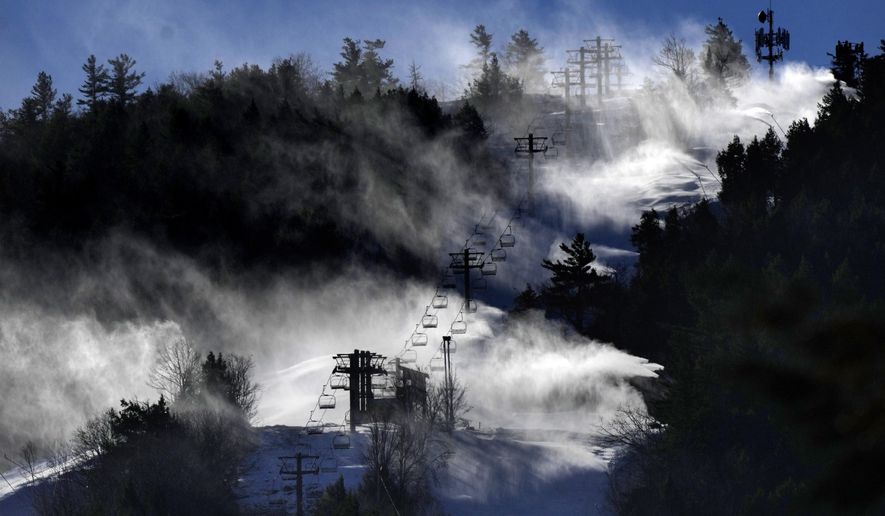For most Americans dreaming of a white Christmas, this year’s prospects aren’t good.
Although parts of the Rockies and Midwest already have snow or could get a fresh dusting by Monday, other parts of the country that are normally coated in white this time of year are still sporting their drab late-fall look.
“Some people will get their dream, their wish, and get a white Christmas right at the last minute,” said Judah Cohen, the director of seasonal forecasting at Verisk Atmospheric and Environmental Research. “But most of the country will have a brown Christmas.”
Among the areas more accustomed to snowy Decembers is the Northeast, where a powerful storm blew in this week and dumped heavy rain on the region’s ski areas, wreaking havoc on the snowpack.
“It didn’t wash out our trails. But it was crazy rain,” said Tom Day, the general manager of Gunstock Mountain Resort in Gilford, New Hampshire.
He hiked the ski area Monday, when it was closed, as 3.5 inches (8.8 centimeters) of warm rain fell and the wind howled.
“That’s a four-letter word, rain, in our business,” Day said.
The snow cover across the U.S. is at near-record lows for this time of year, said Cohen, who doesn’t expect much change by Christmas Day.
“There is a storm that is supposed to come out of the Rockies and head toward Canada, so it looks like some fresh snow in the western Plains, from Kansas to North Dakota,” he said, adding that snow could fall as far west as Denver and as far east as Minnesota.
The National Weather Service also doesn’t foresee a white Christmas for much of the country. But on the bright side, “At least the weather is favorable for most people who have plans to travel this year,” the service wrote in its holiday forecast.
So where should snow lovers turn?
“The best chance for a white Christmas by far is in Alaska,” the service wrote. “Anchorage’s record snow depth on Christmas Day is 30 inches (76 centimeters), which was set back in 1994, and this year’s snow depth could be close to the record.”
Climate change is playing a role in diminishing Christmas snow, Cohen said, although he noted it remains a complicated picture, with extreme cold snaps and unusual weather events occurring.
“Certainly, the globe is warming. Winters are getting shorter. Overall, they’re getting warmer,” Cohen said. “December, I’ve seen the strongest warming. So I feel like December really no longer qualifies as a winter month. The early-season skiing is becoming more and more challenging.”
Despite the challenges, Northeastern snow lovers aren’t giving up. After closing for rain on Monday, Gunstock reopened Tuesday, while many other ski areas took a day or two longer to rebuild trails.
Ryan Sloan, who drove five hours from New York through “intense” rain on Monday to go snowboarding, said Gunstock’s trails on Tuesday weren’t as washed out as he feared they would be.
“The conditions are actually pretty good,” Sloan said. “When you get up to the top, the trails are pretty decent. There are some rocky spots, some icy spots, but overall, pretty good.”
Extensive drainage systems allowed the resort to keep its trails intact, Day said.
In Vermont, the rain caused ski areas to lose some of their natural snow and close some trails, said Bryan Rivard, a spokesperson for Ski Vermont. But he said cold nighttime temperatures forecast for late this week would help them recover.
“Vermont ski areas have some of the most powerful and efficient snowmaking systems in the world, which allows them to stockpile and distribute snow quickly,” Rivard said in an email.
In the Rockies, ski areas have been struggling to open lifts and trails on meager early-season snow. Breckenridge Ski Resort in Colorado, for instance, currently has about 30% of its terrain open, while Mammoth Mountain in California has 48 of its 176 trails open.
And in Eagan, Minnesota, organizers called off the 2024 Minnesota Ice Festival, which had been scheduled to open Jan. 5. The event was going to feature an ice-skating rink, ice slide and a huge ice maze at the Minnesota Vikings’ headquarters, but the warm weather made it risky, Minnesota Ice CEO Robbie Harrell said in a statement.
The good news for Northeast snow lovers is they might not need to wait long after Christmas for fresh powder. Cohen said the weather should get colder just before New Year’s Day and into the first week of January.
“So, new year, hopefully new fortunes as far as snow goes here in the eastern U.S.,” Cohen said.
___
Associated Press writer Jim Salter in O’Fallon, Missouri, contributed to this report.




Please read our comment policy before commenting.